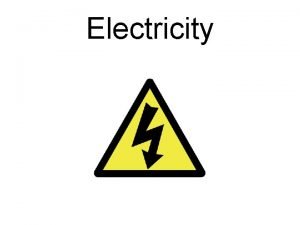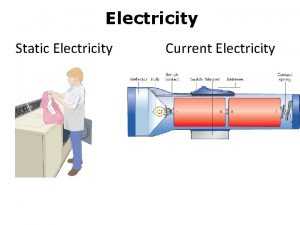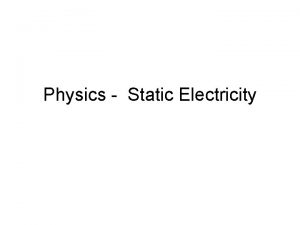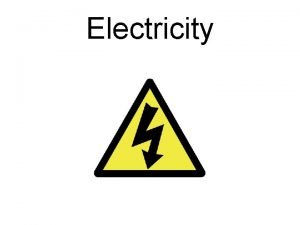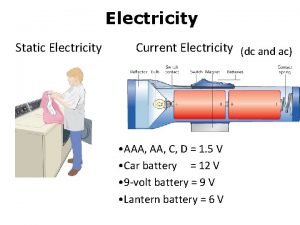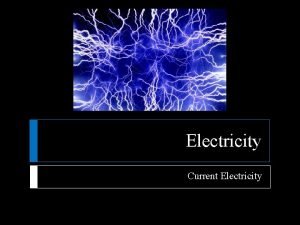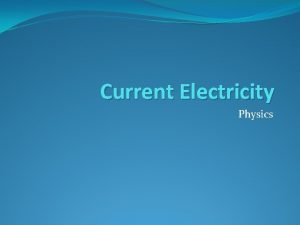Electricity Sector April 2003 Electricity sector in perspective













- Slides: 13

Electricity Sector April 2003

Electricity sector in perspective • Electrification of households is one of Government’s priority programmes • The country generates some of the world’s cheapest electricity • Reticulation of electricity has shifted from parastatals (e. g. Eskom) to municipalities, promoting equity • Three core electricity functions are generation, transmission and distribution • Key role players in the sector – National government through DME: sets policy and legislative framework – Eskom: owns, generation and transmission capacity – Municipalities: distribute electricity to households and other end users – National Electricity Regulator: licenses distributors, oversee standards and regulates tariffs

Sector challenges • Key challenge is restructuring of the industry – To create a competitive industry in generation, transmission and distribution • Two major restructuring decisions were made – Restructure Electricity Distribution Industry (EDI) and create Regional Electricity Distributors (REDs) wholly owned by municipalities – Restructure Electricity Supply Industry (ESI) and sell 30% of Eskom’s generating capacity • Municipalities will play a vital role in distribution – Enabling them to fulfill their constitutional mandates

Electrification backlogs • Backlog estimate of 30% of households nationally • Likely to persist due to increases in informal settlements • Biggest backlogs are in rural areas

Electricity consumption • Total consumption in 2000 was 188 648 megawatts-hours • Manufacturing makes up 40%, followed by domestic at 19% • Gauteng is the biggest user followed by Mpumalanga

Key electrification highlights • Government has allocated R 300 m for free basic electricity to poor households • Poor household connected to a grid to be issued with 50 k. Wh of electricity per month – Translating into average benefit of R 25 p/m • Subsidy of R 48 p/m for non-grid households • 15 000 households to benefit this year and rollout to 300 000 households by 2007 • Department of Minerals and Energy to fund the National Electrification programme, which includes schools and clinics

Size of electricity sector • Eskom recorded electricity revenue of R 28 bn in 2002 • Distributes 60 per cent of electricity to 40 per cent of customers Municipalities are expected to generate R 20 bn or a third of their aggregate budgets • Distributes 40 per cent of electricity to 60 per cent of customers • Through 177 distributors of various size

Electricity tariffs and subsidies • Tariff structures are currently complicated, inequitable and opaque – Due to lack of competition, diverse and discriminatory tariff structures and municipality adopted exemptions • Municipalities to balance provision of free basic services with sustainable revenue generating capacity • Municipal tariff increases should be below inflation targets set by government • High incidences of cross subsidisation has implications for economic activity

Sample municipal electricity budgets • Electricity income of R 1, 9 b comprises 33% of Tshwane budget • For Nelson Mandela Metropole this amount is just over R 800 m • The above amounts exclude annual maintenance spending

Selected Eskom electricity statistics • A major challenge facing Eskom and municipalities is the collection of revenue • Eskom’s 2002 annual report indicated total debtors of R 4, 2 b

Purchases, sales and losses in selected municipalities • Losses range from 13% in Nelson Mandela Metropole to 7% in Middleburg

Employee costs in selected municipalities • The varying employee costs pose a challenge for the restructuring process • This requires standardisation of wages across municipalities

Conclusion • The electricity distribution industry is fragmented – One large supplier, several medium-sized players and many small players • Major risk is that newly created REDs may not be financially sustainable, thereby lowering quality of service delivery • Major task in reform will be the transfer of staff, assets and liabilities • Ability of electricity to be billed separately – Reduction in efficiencies – Reduction in payment in other municipal services
 2003 april 20
2003 april 20 27 april 2003
27 april 2003 Static electricity and current electricity
Static electricity and current electricity Static electricity and current electricity
Static electricity and current electricity Magnetism vocabulary
Magnetism vocabulary Two point perspective staircase
Two point perspective staircase Silo perspective vs business process perspective
Silo perspective vs business process perspective April 2006 calendar
April 2006 calendar International day april 4
International day april 4 April piscids
April piscids April savoy allstate
April savoy allstate What is april dedicated to
What is april dedicated to April ericsson
April ericsson Leonardo da vini
Leonardo da vini

















